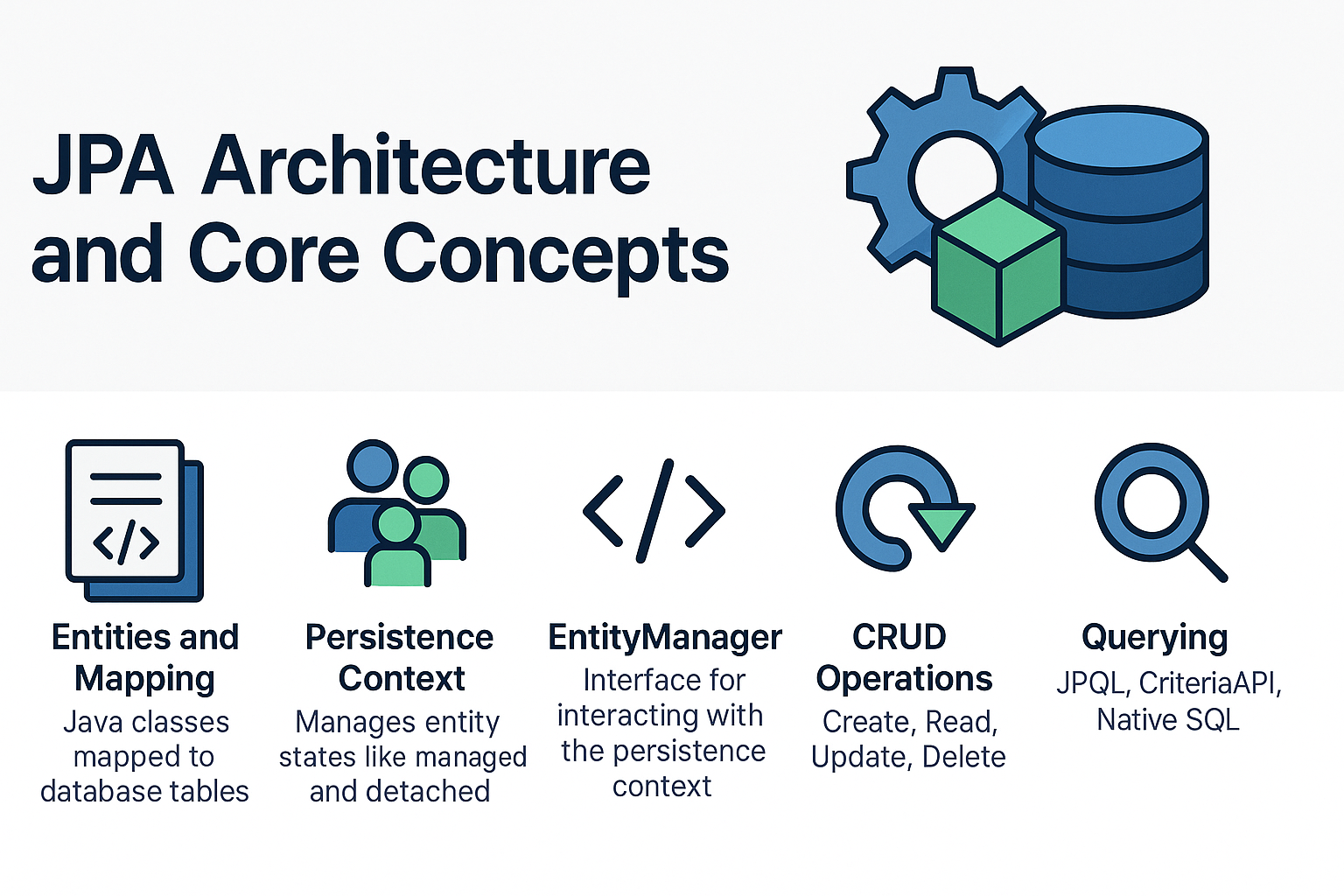Database access is a cornerstone of enterprise Java applications. Traditionally, developers relied on JDBC for raw SQL interaction, but this required writing verbose, error-prone code. To simplify database operations, JPA (Java Persistence API) was introduced as a standard for ORM (Object Relational Mapping) in Java.
In this tutorial, we’ll explore JPA’s architecture and core concepts in detail — including Persistence Context, EntityManager, Entities, and Queries — with practical examples and best practices.
What is JPA?
- JPA (Java Persistence API) is a specification that defines how Java objects (entities) map to relational database tables.
- It removes the need for repetitive SQL code by allowing developers to work with objects instead of raw queries.
- Implementations include Hibernate, EclipseLink, and OpenJPA.
Analogy: Think of JPA as the rulebook, Hibernate as the referee applying those rules, and JDBC as the underlying stadium infrastructure.
JPA Architecture Overview
JPA is built around a few key components:
- EntityManager → Manages entities and database interactions.
- Persistence Context → Tracks entity states (new, managed, detached, removed).
- Entities → Java classes mapped to database tables.
- Queries → JPQL, Criteria API, Native SQL.
- Transaction Management → Ensures consistency during CRUD operations.
High-Level Flow
- Application requests →
EntityManager→ Persistence Context → Database. - Entities are tracked automatically within the persistence context, ensuring synchronization with the database.
Core Concepts in JPA
1. Entities and Mapping
Entities represent database tables.
import jakarta.persistence.*;
@Entity
@Table(name = "users")
public class User {
@Id
@GeneratedValue(strategy = GenerationType.IDENTITY)
private Long id;
private String name;
@Column(unique = true, nullable = false)
private String email;
// Getters & Setters
}
Relationships
- One-to-Many
@OneToMany(mappedBy = "user", fetch = FetchType.LAZY, cascade = CascadeType.ALL)
private List<Order> orders;
- Many-to-One
@ManyToOne
@JoinColumn(name = "user_id")
private User user;
2. Persistence Context
- A Persistence Context is like a classroom attendance register. Once a student (entity) is marked, the teacher (EntityManager) tracks any changes automatically.
Entity States:
- New → Not tracked yet.
- Managed → Tracked in Persistence Context.
- Detached → No longer tracked.
- Removed → Marked for deletion.
em.getTransaction().begin();
User user = new User();
user.setName("Alice");
em.persist(user); // Managed
em.getTransaction().commit();
3. EntityManager
The EntityManager is the gateway to the persistence context.
EntityManagerFactory emf = Persistence.createEntityManagerFactory("examplePU");
EntityManager em = emf.createEntityManager();
em.getTransaction().begin();
User user = new User();
user.setName("Alice");
user.setEmail("alice@example.com");
em.persist(user);
em.getTransaction().commit();
em.close();
emf.close();
4. CRUD Operations
- Create
em.persist(new User("Bob", "bob@example.com"));
- Read
User found = em.find(User.class, 1L);
- Update
em.getTransaction().begin();
found.setName("Updated Bob");
em.merge(found);
em.getTransaction().commit();
- Delete
em.getTransaction().begin();
em.remove(found);
em.getTransaction().commit();
5. Querying
JPQL (Java Persistence Query Language)
List<User> users = em.createQuery("SELECT u FROM User u WHERE u.name = :name", User.class)
.setParameter("name", "Alice")
.getResultList();
Criteria API (Type-Safe Queries)
CriteriaBuilder cb = em.getCriteriaBuilder();
CriteriaQuery<User> query = cb.createQuery(User.class);
Root<User> root = query.from(User.class);
query.select(root).where(cb.equal(root.get("email"), "alice@example.com"));
List<User> results = em.createQuery(query).getResultList();
Native SQL
List<Object[]> results = em.createNativeQuery("SELECT * FROM users").getResultList();
6. Fetching Strategies
- Lazy (default): Load only when accessed.
- Eager: Load immediately with parent entity.
Analogy: Lazy loading = ordering food only when hungry. Eager loading = ordering the full buffet upfront.
@OneToMany(fetch = FetchType.LAZY)
private List<Order> orders;
Performance Considerations
- Beware of the N+1 Select Problem (occurs with lazy loading).
- Use JOIN FETCH or
EntityGraphto solve it. - Optimize with batch fetching, DTO projections, and indexes.
Common Pitfalls
- Misusing CascadeType.ALL → accidental deletions.
- Overusing Eager Fetch → memory overload.
- Ignoring transaction boundaries → inconsistent states.
Best Practices
- Use lazy fetching by default.
- Log SQL queries for debugging (
hibernate.show_sql=true). - Prefer DTOs for read-only projections.
- Always manage transactions carefully.
📌 JPA Version Notes
- JPA 2.0: Introduced Criteria API, Metamodel.
- JPA 2.1: Added stored procedures, entity graphs.
- Jakarta Persistence (EE 9/10/11): Migrated from
javax.persistence→jakarta.persistence.
Real-World Integration
Spring Boot with JPA
@Repository
public interface UserRepository extends JpaRepository<User, Long> {
List<User> findByEmail(String email);
}
Jakarta EE
@Stateless
public class UserService {
@PersistenceContext
private EntityManager em;
public void saveUser(User user) {
em.persist(user);
}
}
Conclusion and Key Takeaways
- JPA standardizes ORM in Java, reducing boilerplate and improving maintainability.
- EntityManager + Persistence Context form the heart of JPA.
- Always optimize queries and fetching strategies for performance.
- JPA is best for enterprise apps, microservices, and Spring Boot integrations.
FAQ
1. What’s the difference between JPA and Hibernate?
JPA is a specification; Hibernate is an implementation.
2. How does JPA handle the persistence context?
Like a register — it tracks entity states and syncs changes.
3. What are the drawbacks of eager fetching in JPA?
Loads unnecessary data, causing performance issues.
4. How can I solve the N+1 select problem with JPA?
Use JOIN FETCH, entity graphs, or batch fetching.
5. Can I use JPA without Hibernate?
Yes, with providers like EclipseLink and OpenJPA.
6. What’s the best inheritance mapping strategy in JPA?
Depends: SINGLE_TABLE (fastest), JOINED (normalized), TABLE_PER_CLASS (less common).
7. How does JPA handle composite keys?
With @EmbeddedId or @IdClass.
8. What changes with Jakarta Persistence?
Package namespace changed from javax.persistence to jakarta.persistence.
9. Is JPA suitable for microservices?
Yes, but limit transaction scope and use DTOs.
10. When should I avoid JPA?
In high-performance analytics or when using NoSQL databases.
